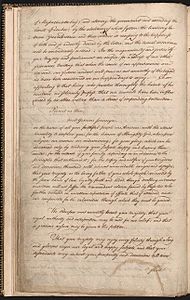Petition to the King facts for kids
Quick facts for kids 1774 Petition to the King |
|
 |
|
| Created | October 1774 |
| Ratified | October 25, 1774 |
| Location | Engrossed copy: Library of Congress |
| Authors | John Dickinson et al. |
| Signers | 51 delegates to the Continental Congress |
| Purpose | Avoiding war between Great Britain and the Thirteen Colonies |
The Petition to the King was a special letter sent to King George III in 1774. It came from the First Continental Congress, a group of leaders from the American colonies. They asked the King to cancel some unfair laws called the Intolerable Acts. When the King said no, it helped lead to the United States Declaration of Independence and the American Revolutionary War. The Congress really hoped to avoid a war.
Contents
Why the Colonies Were Upset
After a big war called the French and Indian War ended in 1763, things got difficult between the Thirteen Colonies and Britain. Britain was deep in debt from the war. So, the British government, through its Parliament, started making new laws to collect more taxes from the colonies.
For example, there was the Stamp Act in 1765 and the Townshend Acts in 1767. Britain thought these taxes were fair ways to pay off its war debts.
However, many colonists in America saw things differently. They argued that because they didn't have their own representatives in Parliament, Parliament shouldn't be able to tax them. This idea was summed up as "No taxation without representation!"
After colonists threw a lot of British tea into the harbor during the Boston Tea Party, Parliament passed even stricter laws in 1774. These were called the Coercive Acts. They were meant to punish the colonies. The colonists strongly opposed these harsh new laws. This led to the creation of the Continental Congress. This group wanted to talk to King George III and find a peaceful solution.
Creating the Important Document
The Idea for the Petition
Resolved unanimously, That a loyal address to his Majesty be prepared, dutifully requesting the royal attention to the grievances that alarm and distress his Majesty's faithful subjects in North-America, and entreating his Majesty's gracious interposition for the removal of such grievances, thereby to restore between Great-Britain and the colonies that harmony so necessary to the happiness of the British empire, and so ardently desired by all America.
—First Continental Congress, October 1, 1774
On October 1, 1774, the First Continental Congress decided to write a statement to King George III. The goal was to convince the King to remove the unpopular laws, especially the Coercive Acts. A committee was formed to write this important letter. Key members included Richard Henry Lee, John Adams, and Patrick Henry.
On October 5, 1774, Congress emphasized that the letter should assure the King of the colonies' loyalty. They wanted to show that if the unfair laws were removed, good relations with Britain would return.
Congress Approves the Petition
The Congress resumed the consideration of the address to his Majesty, and the same being debated by paragraphs, was, after some amendments, approved and order to be engrossed.
Resolved, That the address to the King be enclosed in a letter to the several colony Agents, in order that the same may be by them presented to his Majesty; and that the Agents be requested to call in the aid of such Noblemen and gentlemen as are esteemed firm friends to American liberty.—First Continental Congress, October 19, 1774
On October 25, 1774, the draft of the petition was reviewed by Congress. After some discussions and changes, it was officially approved. It was then prepared in its final, formal version to be sent to England.
Sending the Petition to the King
The petition left Philadelphia on November 2 on a ship called Britannia. However, a storm forced the ship to return to port. It was also found that the paper used was not suitable. A second copy was sent on November 6 on the ship Mary and Elizabeth.
On December 14, it was confirmed that the petition had successfully arrived in London. In Britain, Benjamin Franklin, who was representing the colonies, met with British officials. On December 21, Lord Dartmouth told Franklin that the petition was "decent and respectful." He promised it would be shown to Parliament soon. However, Franklin later learned it wouldn't be presented until after the Christmas break.
Making the Petition Public
When the official papers of Congress were first published in late 1774, the Petition to the King was not included. This was because Congress wanted the King to read it first before it became public. It wasn't until January 17 or 18, 1775, that the petition was officially released by Charles Thomson, the secretary of the Continental Congress, for everyone to read.
Different Drafts of the Petition
Three early versions, or drafts, of the Petition to the King still exist today. One was written by Patrick Henry, another by Richard Henry Lee, and a third by John Dickinson.
- The Henry draft focused more on describing the unfairness of the Acts.
- The Lee draft was shorter but included strong criticisms of the King's advisors.
- The Dickinson draft is very similar to the final version that Congress approved. It shows many changes as it was being written.
Why This Petition Was Important
The Petition to the King showed that the American colonies still wanted to have a good relationship with Britain. But they had clear demands that needed to be met. It also highlighted that the colonies felt loyal to the British King, but not necessarily to the British Parliament. This difference in loyalty would become a major issue leading up to the American Revolution.
See also

